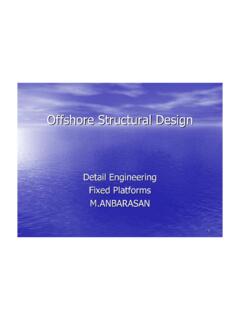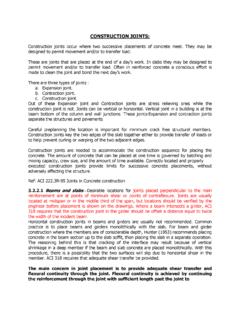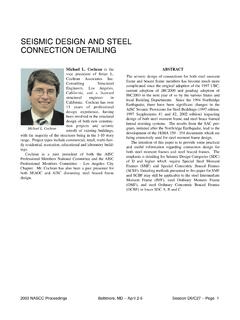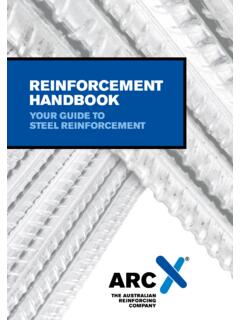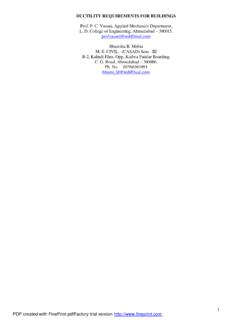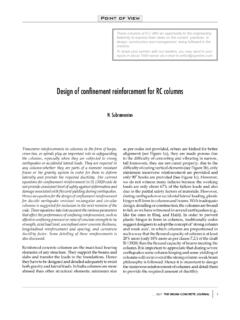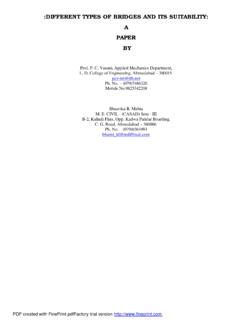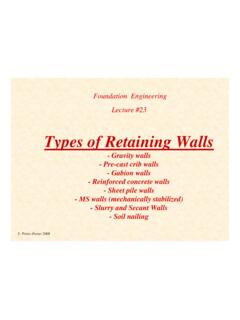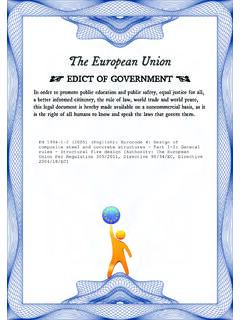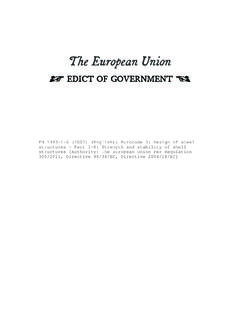Transcription of Properties of concrete for use in Eurocode 2
1 CCIP-029 Properties of concrete for use in Eurocode 2P. B a m f o r t h D. Chisholm T. Harrison Properties of concrete for use in Eurocode 2 This publication is aimed at providing both civil and structural design engineers with a greater knowledge of concrete behaviour. This will enable the optimal use of the material aspects of concrete to be utilised in design . Guidance relates to the use of concrete Properties for design to Eurocode 2 and the corresponding UK National the design of concrete structures, engineers have the fl exibility to specify particular concrete type(s) to meet the specifi c performance requirements for the project. For instance where calculated defl ections exceed serviceability limits, the designer can achieve lower defl ections by increasing the class of concrete and the associated modulus of elasticity, rather than by resizing members.
2 This publication will assist in designing concrete structures taylor-made for particular Published January 2008 ISBN 978-1-904482-39-0 Price Group P The concrete CentreRiverside House, 4 Meadows Business Park,Station Approach, Blackwater, Camberley, Surrey, GU17 9 ABTel: +44 (0)1276 606 800 Phil Bamforth spent his early career managing construction consultancy and research for Taywood Engineering, and has a wide experience in concrete technology and construction both in the UK and abroad. Now in private consultancy, supporting design and construction activities in concrete , he has written numerous papers related to concrete material Chisholm is project manager for technical publications at The concrete Centre and has a background in concrete materials technology. John Gibbs is technical advisor for the European Ready-Mixed concrete Organisation (ERMCO).
3 He has spent most of his career in the ready-mixed, quarrying and construction industries. Tom Harrison is technical director of the British-Ready Mix concrete Association and in that capacity chaired the committee that produced Guidance to the Engineering Properties of concrete from which this publication has of concrete for use in Eurocode 2 How to optimise the engineering Properties of concrete in design to Eurocode 2A cement and concrete industry publicationP. B a m f o r t h BSc (Hons) PhD C Eng BE (Hons) CPEng IntPE(NZ) BA BSc PhD C Eng FICT MICEP roperties of 1 Properties of 124/01/2008 12:17:2824/01/2008 12:17:28 Properties of concrete for use in Eurocode 2 ContentsSymbols ii1. Introduction 12. Assumptions underlying Eurocode 2 43.
4 Compressive strength 54. Tensile strength 115. Bond strength 176. Modulus of elasticity 197. Tensile strain capacity 248. Creep 269. Shrinkage 3010. Thermal expansion 3511. Thermal conductivity 3712. Specifi c heat 3813. Fire resistance 3914. Adiabatic temperature rise 4215. Durability 4516. The use of recycled aggregates 47 References 48 Appendix A 51iiSymbolsc cover to reinforcementcp specifi c heatcv coeffi cient of variationD thermal diffusivityEc tangent modulusEcd design value of modulus of elasticity of concreteEc,eff effective modulus of elasticity of concreteEcm mean secant modulus of elasticity of concretefbd ultimate ( design )
5 Bond stressfcd design compressive strengthfcd,fat design fatigue strength fck specifi ed characteristic cylinder compressive strengthfck,c confi ned characteristic compressive strengthfck,cube specifi ed characteristic cube compressive strength fcm mean concrete cylinder compressive strengthfcm,cube mean concrete cube compressive strength fctd design tensile strengthfctk characteristic axial tensile strength of concretefctm mean axial tensile strengthfctm,sp mean splitting tensile strengthfctm,fl mean fl exural tensile strengthfct,sp tensile splitting strengthfcu specifi ed characteristic cube compressive strength (BS 8110 term)s coeffi cient for cement type used with the age functionsr,max crack spacingt time coeffi cient applied to age function c coeffi cient of thermal expansion cc coeffi cient for long-term and loading effects on compressive strength ct coeffi cient for long-term and loading effects on tensile strength cc(t)
6 Age function for strength c partial safety factor for strength of concrete cE partial safety factor for strength of concrete used with Ecm m partial safety factor for strength of a material ca(t) autogenous shrinkage strain up to time t ca( ) autogenous shrinkage strain at time t = cc ( ,t0) creep deformation at time t = cd drying shrinkage strain cs total shrinkage strain ctu tensile strain capacity 1 coeffi cient related to bond condition 2 coeffi cient related to bar diameteriii c thermal conductivity density p,eff ratio of area of reinforcement to effective area of concrete f bar diameter ( , t0) creep coeffi cient at time t = c constant compressive stress applied at time t = t0 1 Introduction1.
7 IntroductionIn the design of concrete structures, engineers have the fl exibility to specify particular concrete type(s) aimed at meeting the specifi c performance requirements for their project. For instance where calculated defl ections exceed serviceability limits, the designer can achieve lower defl ections by increasing the class of concrete and the associated modulus of elasticity, rather than by resizing this fl exibility goes the responsibility for ensuring that the quality control in concrete production and subsequent site operations will enable the concrete as cast to meet the specifi ed requirements in service. Typically concrete is specifi ed by compressive strength class, which indicates the characteristic compressive strength required. However, in design , a range of Properties of concrete are used that are not normally part of the concrete specifi cation.
8 These may relate to both structural integrity and serviceability. BS EN 1992-1-1, ( Eurocode 2: design of concrete structures, Part 1-1 General rules and rules for buildings) Section 3: Materials details these Properties which are generally assumed to be related to the cylinder compressive strength, expressed either as the characteristic or the mean value, and are calculated using expressions which include one or other of these values. This publication covers the background to the use of concrete Properties in design , and is structured to provide guidance on: the range of concrete Properties required in the design process. how each property is determined in BS EN 1992-1-1. how the property can be measured. how the measured value may be used in design . options for modifying the value of the guidance is intended to provide design engineers with a greater knowledge of concrete behaviour, so that they can optimise the use of the material aspects of concrete in their design .
9 Section 3 of BS EN 1992-1-1 gives principles and rules for normal- and high-strength concrete (15 105 MPa cube strength) and for normal-weight concrete . Lightweight aggre-gate concrete (< 2200kg/m3) is covered in section 11 of the Code and is not covered in this is given on the use of Eurocode2 (EC2) and on the corresponding UK National Annex (generally to Eurocode 2-1-1). Where a nationally determined parameter which specifi cally applies to the UK is given, this is stated or denoted (NDP), and this value may be different for other CEN member an equation from Eurocode 2 is quoted, the Eurocode equation reference is highlighted alongside the equation in the list of European, national and international standards referred to in this publication is given under references at the ScopeEC22BS EN 1992-1-1 ( Eurocode 2: design of concrete structures, Part 1-1) sets out rules for the design of concrete structures and in table gives recommended values for various mechanical Properties of concrete for use in design .
10 These property values are based on a number of assumptions and in general will be conservative. In most cases, these design values will be appropriate; however, in some circumstances the assumed design value may limit the design possibilities. Engineers who wish to take advantage of the full potential of concrete construction may therefore wish to look at the design values more closely to identify where changes may be cost-effective. This may be the case with the current trend to use higher-strength concrete , when serviceability considerations may start to control the design As an example, if a higher value of modulus could be achieved, slab spans could be increased without increasing thickness. Use of high-strength concrete can also lead to lower shrinkage and creep values. Designers may therefore wish to specify a value higher than the value from table for a particular property and this guide provides information on how this may be achieved.
